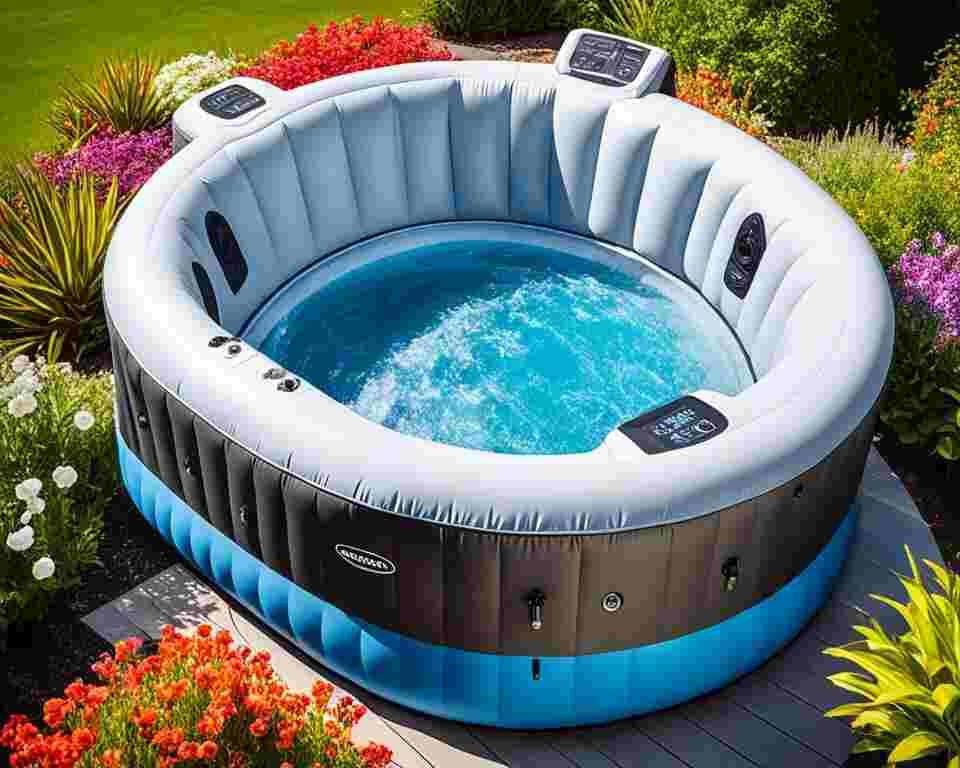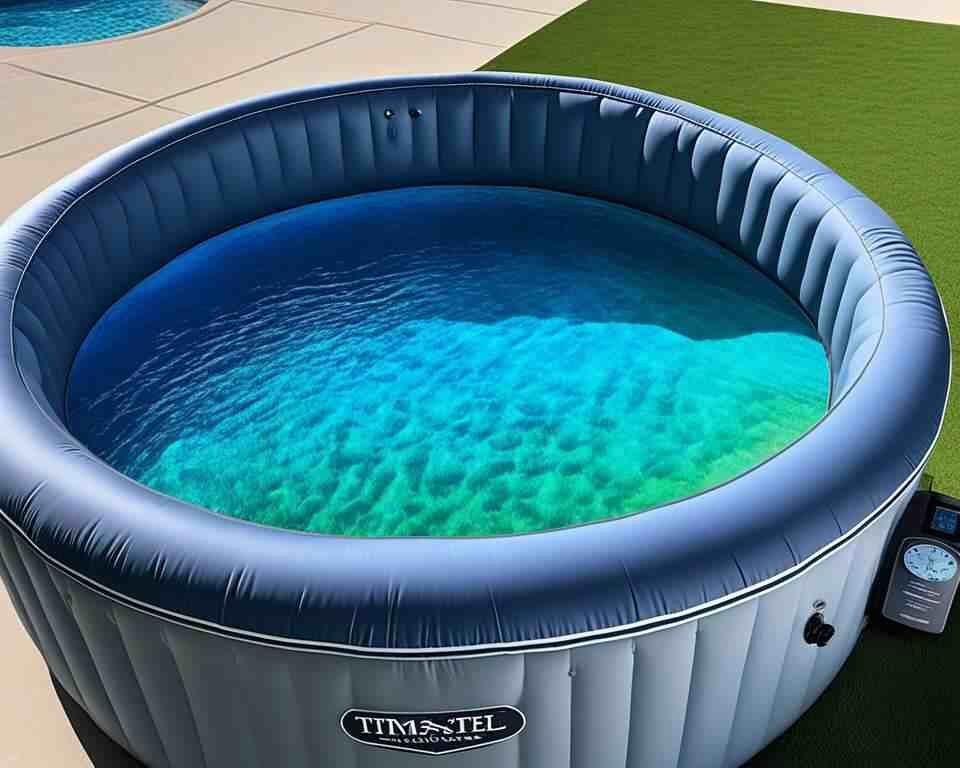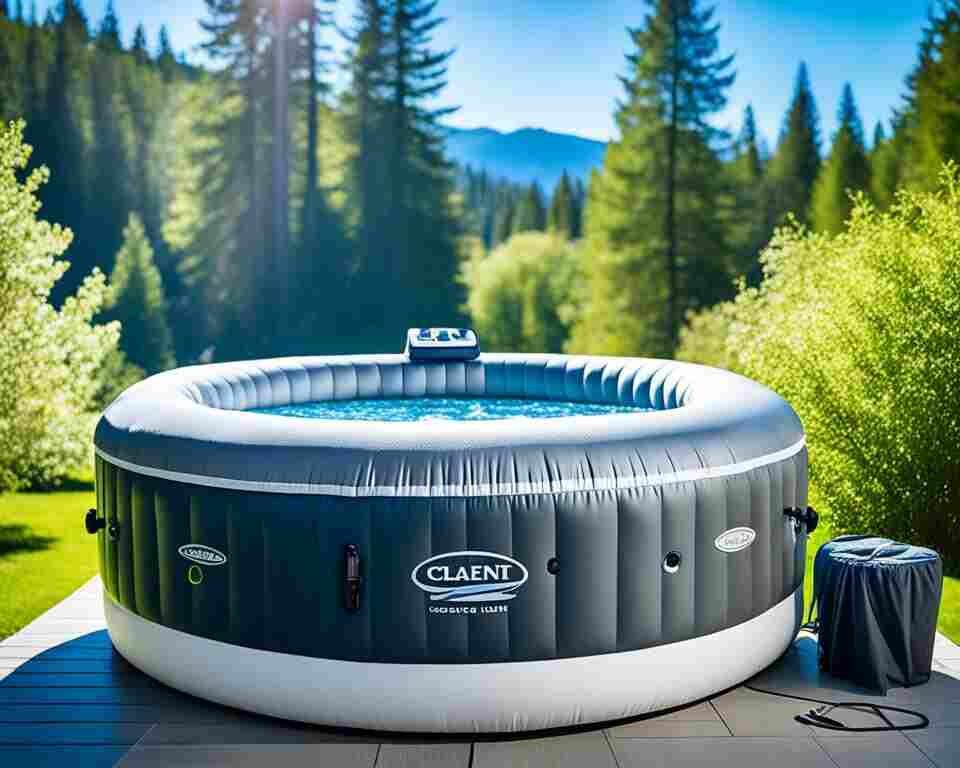Ever wondered about the perfect balance of chlorine in your inflatable hot tub? Perhaps you’ve pondered how frequently to add this essential chemical for optimal water quality.
As hot tub enthusiasts, we’ve all been there, grappling with the question: How often do you put chlorine in an inflatable hot tub?
Join me as I dive into the intricacies of hot tub maintenance, exploring the science behind chlorine application and debunking common myths along the way.
Key Takeaways
- Handle and Store Chlorine Safely: Always follow manufacturer instructions for handling, storing, and disposing of chlorine products. Store them in a cool, dry place away from sunlight and moisture, and wear protective gear when handling.
- Minimize Chlorine Odor and Irritation: Ensure proper water circulation and filtration to prevent the buildup of chloramines, which cause strong chlorine smells. Shower before entering the hot tub to remove contaminants from your skin, and consider using non-chlorine shock treatments periodically.
- Balance Chlorine with Other Chemicals: Regularly test and adjust pH and alkalinity levels to maintain water balance and ensure optimal chlorine effectiveness. Keep pH levels within the range of 7.2-7.6 and total alkalinity between 80-120 ppm.

Understanding the Importance of Chlorine
Chlorine is a chemical that helps clean water. In hot tubs, it’s especially important because warm water can be a breeding ground for bacteria. When people use the hot tub, they can leave behind things like sweat and oils, which can make the water dirty and unsafe.
Factors Affecting Chlorine Demand
A few things can affect how much chlorine you need in your hot tub:
- Water Temperature: Warmer water can make chlorine break down faster, so you might need to add more often.
- Bather Load: If a lot of people use the hot tub or if they stay in for a long time, you’ll need more chlorine to keep the water clean.
- pH Levels: The balance of chemicals in the water, like pH, can affect how well chlorine works. If the balance is off, you might need to adjust it.
- Environmental Factors: If your hot tub is outside, things like leaves or dirt can get in the water, which means you might need more chlorine to keep it clean.
Keeping the right amount of chlorine in your hot tub is important for keeping the water safe and enjoyable. Testing the water regularly and following maintenance guidelines can help make sure your hot tub stays clean and healthy.
Chlorine Application Methods for Inflatable Hot Tubs
Ensuring your inflatable hot tub maintains safe and clean water conditions requires understanding the different methods available for applying chlorine. Let’s explore these methods in detail:
Traditional Chlorine Products
Chlorine Tablets
Pros:
- Slow Dissolving: Tablets dissolve gradually, providing a consistent release of chlorine.
- Convenience: Easy to use, requiring less frequent maintenance.
- Cost-effective: Relatively inexpensive and widely available.
Cons:
- Risk of Overdosing: Improper use can lead to over-chlorination.
- Stabilizer Buildup: Some tablets contain stabilizers that can accumulate in the water over time.
Granular Chlorine
Pros:
- Quick-acting: Dissolves rapidly, providing a rapid boost of chlorine levels.
- No Stabilizers: Does not contain stabilizers, making it suitable for hot tubs with high cyanuric acid levels.
- Versatile: Can be used for regular maintenance and shock treatments.
Cons:
- Requires Dilution: Should be pre-dissolved to prevent damage to the tub surface.
- More Frequent Application: Needs to be added more frequently than tablets.
Alternatives to Traditional Chlorine
Chlorine Floaters
Pros:
- Ease of Use: Minimal setup and maintenance required.
- Adjustable: Some floaters allow for control of chlorine release rate.
Cons:
- Imbalance Risk: Improper adjustment can lead to water chemistry imbalances.
- Limited Capacity: Requires regular refilling.
Chlorine Generators
Pros:
- Continuous Production: Generates chlorine on-demand for consistent sanitation.
- Reduced Chemical Handling: Minimizes the need for manual chemical dosing.
Cons:
- Initial Cost: Higher upfront investment compared to traditional methods.
- Maintenance Requirements: Requires periodic cleaning and monitoring for optimal performance.
By understanding these chlorine application methods, you can make an informed decision on the best approach for keeping your inflatable hot tub water clean and safe for use.

Determining Chlorine Frequency for Inflatable Hot Tubs
When it comes to deciding how often you need to add chlorine to your inflatable hot tub, a few factors come into play. Let’s dive into creating a suitable schedule for maintaining chlorine levels:
Regular Chlorine Maintenance Schedule
Daily Chlorine Checks
Weekly Chlorine Shocking
Once a week, it’s a good idea to give your hot tub a chlorine shock treatment. This involves adding a higher-than-normal amount of chlorine to the water. Doing this helps get rid of any buildup of organic matter like body oils, sweat, and sunscreen residues. It prevents cloudy water, bad smells, and potential health risks.
Adjusting Chlorine Usage Based on Usage and Conditions
Heavy Usage Considerations
If your hot tub gets a lot of use, like if many people are using it frequently or for long periods, you might need to add chlorine more often. More people mean more contaminants like body oils and sweat, which use up chlorine faster. In such cases, you’ll want to test the water more often and add chlorine when needed to keep it clean and safe.
Environmental Factors
The environment around your hot tub can also affect how quickly chlorine is used up. Things like sunlight, temperature changes, and weather conditions can make chlorine break down faster. For instance, hot and sunny weather speeds up chlorine loss, so you may need to add more chlorine more often. Rain or wind can also introduce dirt and other pollutants into the water, requiring extra chlorine to keep it sanitized.
By keeping an eye on how often you use your hot tub and what’s happening in the surrounding environment, you can adjust your chlorine routine to make sure your hot tub water stays clear and safe for everyone to enjoy.
Monitoring and Testing Chlorine Levels
Maintaining the right chlorine levels in your inflatable hot tub is vital for keeping the water clean and safe. Regularly checking and testing the chlorine levels helps prevent bacteria and algae growth, ensuring a healthy environment for you to enjoy.
Importance of Regular Testing
Regularly checking the chlorine levels is crucial to ensure your hot tub water is properly sanitized. Without enough chlorine, harmful bacteria can grow, which can pose health risks. By testing the chlorine levels often, you can catch any issues early and take action to keep the water safe.
Recommended Testing Equipment
There are a few different ways to test the chlorine levels in your hot tub:
Test Strips:
These are easy to use and give quick results. You just dip the strip in the water and compare the color to a chart.
Liquid Test Kits:
These kits provide more precise results. You add a few drops of a testing solution to a water sample and observe the color change.
Interpreting Test Results
Understanding your test results is essential for maintaining the right chlorine levels:
Ideal Chlorine Levels:
The recommended chlorine level for hot tubs is usually between 3 to 5 parts per million (ppm). If it’s too low, you need more chlorine, and if it’s too high, you may need to dilute the water or use a neutralizer.
By regularly testing and adjusting the chlorine levels in your inflatable hot tub, you can ensure the water stays clean and safe for everyone to enjoy.
Apologies for that oversight! Let me correct the formatting for you:
Apologies for the confusion. Let’s correct the headings:
Got it! Let’s refine the formatting:

Tips for Safe and Effective Chlorine Use
Handling and Storage Precautions
- Proper handling and storage of chlorine products are essential for ensuring safety and effectiveness in maintaining water quality in your inflatable hot tub.
- Store chlorine products in a cool, dry place away from direct sunlight and moisture to prevent degradation.
- Always follow manufacturer instructions for handling, storing, and disposing of chlorine products safely.
- When handling chlorine tablets or granules, wear protective gloves and goggles to avoid skin and eye irritation.
- Keep chlorine products out of reach of children and pets to prevent accidental ingestion or contact.
Minimizing Chlorine Odor and Irritation
- Chlorine is an effective sanitizer but can sometimes lead to unpleasant odors or skin irritation if not properly managed.
- To minimize chlorine odor, ensure proper water circulation and filtration in your inflatable hot tub to prevent the buildup of chloramines, which can cause strong chlorine smells.
- Showering before entering the hot tub can help remove oils, sweat, and other contaminants from your skin, reducing the demand for chlorine and minimizing irritation.
- Consider using a non-chlorine shock treatment periodically to oxidize organic contaminants and maintain water clarity without adding additional chlorine.
Balancing Chlorine with Other Chemicals
- Maintaining proper water chemistry is crucial for effective chlorine sanitization and overall water quality in your inflatable hot tub.
- Regularly test and adjust pH levels to ensure they remain within the optimal range (typically 7.2-7.6) for chlorine effectiveness.
- Alkalinity levels also play a role in water balance, helping to stabilize pH and prevent fluctuations that can affect chlorine activity.
- Use pH and alkalinity adjusting chemicals as needed to maintain balance and ensure chlorine works efficiently to sanitize the water.
| Water Parameter | Ideal Range |
|---|---|
| pH | 7.2 – 7.6 |
| Total Alkalinity | 80 – 120 ppm |
By following these tips, you can safely and effectively maintain chlorine levels in your inflatable hot tub, ensuring clean and comfortable water for relaxation and enjoyment.
Inflatable Hot Tub Chlorine Use Case
Scenario:
John recently purchased an inflatable hot tub to enjoy relaxing evenings in his backyard with his family and friends. However, after a few weeks of use, he noticed that the water in his hot tub started to appear cloudy and had a faint odor. Concerned about the water quality and the health implications for his family, John began researching how to maintain proper chlorine levels in his inflatable hot tub.
Discovery:
After some online searching, John came across an article titled “How Often Do You Put Chlorine in an Inflatable Hot Tub?” The intriguing question immediately caught his attention, prompting him to delve deeper into the topic.
Exploration:
As he read through the article, John discovered valuable insights into the importance of chlorine in hot tub maintenance, the factors influencing chlorine frequency, and practical tips for achieving optimal water quality.
Resolution:
Armed with this newfound knowledge, John learned how to strike the right balance of chlorine in his hot tub, ensuring clean and safe water for his family’s enjoyment.
Outcome:
With a clearer understanding of chlorine application and maintenance, John felt confident in his ability to keep his inflatable hot tub pristine and inviting, ready for many more relaxing evenings ahead with his loved ones.
This use case illustrates how an intriguing question about chlorine frequency in an inflatable hot tub led John to discover essential information that empowered him to maintain optimal water quality and enjoy his hot tub to the fullest.
Conclusion
Maintaining proper chlorine levels in your inflatable hot tub is crucial for a safe and enjoyable experience. By following the provided guidelines for handling and storage, minimizing odor and irritation, and balancing chlorine with other chemicals, you can effectively manage your hot tub’s water chemistry.
By handling chlorine products with care, ensuring proper water circulation, and regularly testing and adjusting pH and alkalinity levels, you can enjoy clean and comfortable water in your inflatable hot tub, enhancing your relaxation and enjoyment.

